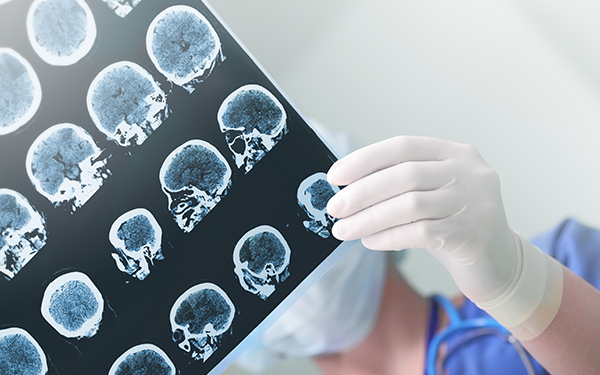Stroke
Strokes, sometimes referred to as cerebrovascular accidents, are medical emergencies capable of causing severe neurological damage, permanent disability, and even death. In our country, one life is lost to a stroke every 4 minutes, nearly 50% of all stroke survivors over 65 become disabled with one-sided movement difficulty, and 25% are permanently unable to care for themselves. There are many risk factors for stroke, some of which include age, gender, high blood pressure, diabetes, and previous episodes of stroke.
Strokes occur when the blood supply to the brain ceases. Blood carries vital oxygen and nutrients that the brain requires to function. There are two main reasons why blood flow to the brain may cease, and therefore two main types of strokes:
- Ischemic strokes (also known as dry strokes) occur when blood flow is impeded by a physical blockage in a blood vessel. These incidents account for 87% of all strokes. There are two kinds of ischemic stroke: thrombotic (a clot forms in a blood vessel) and embolic (a clot from somewhere else lodges in a vessel).
- Hemorrhagic strokes (also known as wet strokes) occur when a blood vessel ruptures and bleeds. There are two types of hemorrhagic strokes – outside and inside. An outside hemorrhagic stroke (also known as a subarachnoid hemorrhage or subdural hematoma) is caused by a ruptured blood vessel outside the brain but inside the skull. These are often characterized by a sudden severe headache described by patients as the “worst headache of my life.” An inside hemorrhagic stroke (also known as an intracerebral hemorrhage) occurs when a vessel ruptures within the brain. Only rarely do these types of strokes present with a headache.
Besides these two main categories, there is a less severe type of stroke called a transient ischemic attack (TIA), often referred to as a “mini” stroke or a “silent” stroke. This type of stroke usually lasts only a few hours, but it increases future stroke risk and can have long-term consequences such as memory loss. While TIAs lack obvious stroke-like symptoms and commonly go unnoticed, they are detectable on imaging of the brain.
Symptoms & Diagnosis
The specific effects of a stroke depend upon the location and extent of brain damage. The most common complications of stroke are listed below:
- Aphasia is the result of stroke-induced damage to brain regions involved in speech and language processing.
- Pain may be experienced immediately following a stroke or weeks to months later. Mechanical pain may be caused by damaged muscle or joint tissue.
- Uncontrollable episodes of laughing or crying (known as pseudobulbar affects) occur with a stroke to the brainstem or cerebral cortex. Since the brainstem houses our life-support functions, breathing and heart rate can be affected.
- Vascular dementia is described as problems with mental and cognitive abilities such as memory loss, confusion, and decreased attention span.
- Paralysis or spasticity is due to paralyzed or stiffened muscles on the opposite side of the body from the initial damage in the brain.
- Balance and coordination problems can be a result of damage to the cerebellum which is located to the back of the brain.
Medical Treatment
It is critical to treat stroke victims quickly to avoid widespread brain damage. Calling 911 immediately upon experiencing stroke symptoms is vital in ensuring optimal medical treatment. Once a stroke victim has arrived at the hospital, physicians use imaging tests, such as CT scans, MRIs, and MRAs to detect the location and nature of the stroke. Determining the type of stroke is critical since the medications used to treat the blockage of ischemic stroke will not work for treating the bleeding of hemorrhagic stroke, and vice versa.
Emergency treatment of ischemic stroke is targeted at dissolving the clot. To help prevent secondary stroke, patients may be prescribed anti-platelet therapy including low-dose aspirin, Plavix, or anticoagulant therapy such as long-term warfarin (aka Coumadin). It is critical to understand that these medications may reduce ischemic stroke risk but subsequently increase hemorrhagic stroke risk.
In the case of a hemorrhagic stroke, emergency treatment focuses on controlling bleeding and reducing pressure within the brain. Medications may be prescribed to control blood pressure which is considered a major risk factor for a second stroke. Prescription drugs for lowering blood pressure include diuretics, calcium channel blockers, beta blockers, and ACE inhibitors. These drugs either decrease blood volume, slow down the heart, or increase the size of arteries, but each carries its own list of possible side effects.

Our approach to stroke emphasizes both preventative therapies as well as therapies to improve compromised brain function. We utilize nutritional and neurological testing to help identify correctable factors involved in stroke. We then help you take proactive steps in avoiding this debilitating condition by implementing specific nutritional interventions and lifestyle modifications.
For those who have already experienced the brain-damaging effects of a stroke, Divine Design Natural Health can help facilitate your path to recovery. We recognize the lifesaving capabilities of conventional medications and surgeries, but we are also aware of their potential side effects and limited ability to target the multiple factors that contribute to stroke. Although many people have been led to believe that chiropractic adjustments cause strokes, the reality is that natural health treatment has actually been shown to help diminish the brain damaging effects of stroke through detoxification, cold laser therapy, and neurologically-based methods of care. With the proper care plan in place and a patient’s active participation in their treatment, we have had great success in restoring function and vitality to patients looking for effective treatment solutions.



